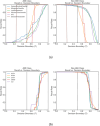Machine learning for predicting acute myocardial infarction in patients with sepsis
- PMID: 39719483
- PMCID: PMC11668874
- DOI: 10.1038/s41598-024-80575-z
Machine learning for predicting acute myocardial infarction in patients with sepsis
Abstract
Acute myocardial infarction (AMI) and sepsis are the leading causes of high mortality rates in intensive care units. While sepsis frequently affects the cardiovascular system, distinguishing between sepsis-induced cardiomyopathy and AMI remains challenging due to overlapping biomarkers. Misdiagnosis can hinder timely treatment and increase risk of complications. This study used multidimensional clinical data and machine learning techniques to develop and validate a novel predictive model for identifying AMI in critically ill patients with sepsis. Data from patients with sepsis were extracted from the Medical Information Mart for Intensive Care-IV database. Six machine learning algorithms were employed for model construction. Additionally, the machine learning-based models were compared with traditional scoring systems. Model performance was evaluated in terms of discrimination, calibration, and clinical applicability. In total, 2,103 critically ill patients with sepsis were included, 459 (21.8%) of whom experienced AMI during hospitalization. A total of 26 variables were selected for model construction. Among all models, the Gradient Boosting Classifier model demonstrated the best predictive performance in terms of discrimination, calibration, and clinical applicability. Machine learning models have the potential to serve as tools for predicting AMI in patients with sepsis. The Gradient Boosting Classifier model developed herein demonstrated promising predictive performance, supporting clinicians in identifying patients at high-risk of sepsis and implementing early interventions to reduce mortality rates.
Keywords: Acute myocardial infarction; MIMIC-IV database; Machine learning; Prediction model; Sepsis.
© 2024. The Author(s).
Conflict of interest statement
Declarations. Competing interests: The authors declare no competing interests.
Figures








Similar articles
-
Machine learning for the prediction of acute kidney injury in patients with sepsis.J Transl Med. 2022 May 13;20(1):215. doi: 10.1186/s12967-022-03364-0. J Transl Med. 2022. PMID: 35562803 Free PMC article.
-
Early prediction of sepsis associated encephalopathy in elderly ICU patients using machine learning models: a retrospective study based on the MIMIC-IV database.Front Cell Infect Microbiol. 2025 Apr 17;15:1545979. doi: 10.3389/fcimb.2025.1545979. eCollection 2025. Front Cell Infect Microbiol. 2025. PMID: 40313459 Free PMC article.
-
Using machine learning methods to predict in-hospital mortality of sepsis patients in the ICU.BMC Med Inform Decis Mak. 2020 Oct 2;20(1):251. doi: 10.1186/s12911-020-01271-2. BMC Med Inform Decis Mak. 2020. PMID: 33008381 Free PMC article.
-
Machine learning for the prediction of sepsis-related death: a systematic review and meta-analysis.BMC Med Inform Decis Mak. 2023 Dec 11;23(1):283. doi: 10.1186/s12911-023-02383-1. BMC Med Inform Decis Mak. 2023. PMID: 38082381 Free PMC article.
-
Machine learning for predicting mortality in adult critically ill patients with Sepsis: A systematic review.J Crit Care. 2024 Dec;84:154889. doi: 10.1016/j.jcrc.2024.154889. Epub 2024 Jul 25. J Crit Care. 2024. PMID: 39059094
Cited by
-
Generative adversarial networks with texture recovery and physical constraints for remote sensing image dehazing.Sci Rep. 2024 Dec 28;14(1):31426. doi: 10.1038/s41598-024-83088-x. Sci Rep. 2024. PMID: 39733123 Free PMC article.
-
The role of KRT18 in lung adenocarcinoma development: integrative bioinformatics and experimental validation.Discov Oncol. 2024 Dec 27;15(1):841. doi: 10.1007/s12672-024-01728-0. Discov Oncol. 2024. PMID: 39729139 Free PMC article.
-
Inulin biopolymer as a novel material for sustainable soil stabilization.Sci Rep. 2024 Dec 28;14(1):31078. doi: 10.1038/s41598-024-82289-8. Sci Rep. 2024. PMID: 39730738 Free PMC article.
References
-
- Rhodes, A. et al. Surviving sepsis campaign: International guidelines for Management of Sepsis and Septic Shock: 2016. Intensive Care Med.43, 304–377 (2017). - PubMed
-
- Frencken, J. F. et al. Myocardial Injury in patients with sepsis and its association with long-term outcome. Circ: Cardiovasc. Qual. Outcomes11, e004040 (2018). - PubMed
MeSH terms
Grants and funding
LinkOut - more resources
Full Text Sources
Medical

